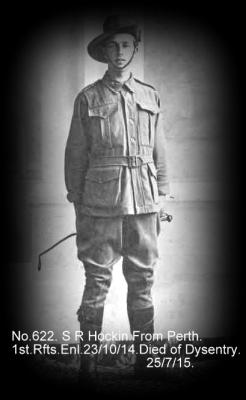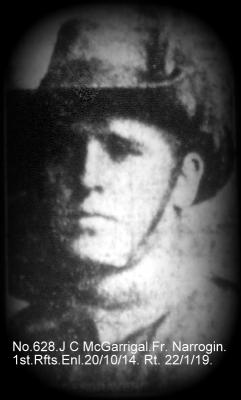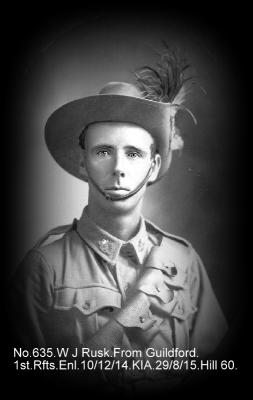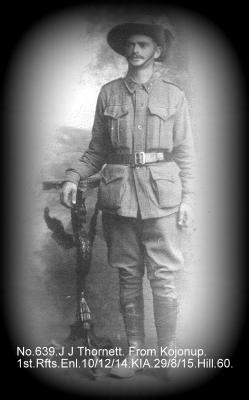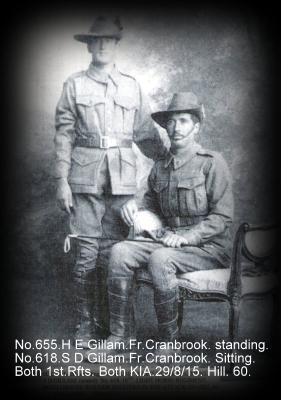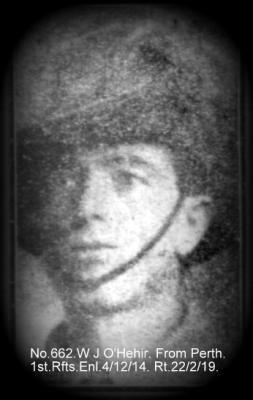World War 1, Australia, Western Australia, DOWDELL, 10 Light Horse
Photograph of 615 Trooper William Thomas Dowdell of Tenterden, killed in action, 12 October 1917 at Passchendaele
10 Light Horse was raised as a squadron, then a regiment in October 1914.and formed part of the 3rd Light Horse Brigade in Egypt. The Regiment served dismounted in Gallipoli and fought at the charge at the Nek on 7 August 1915, and at Hill 60 on 29-30 August. The only Victoria Cross awarded to a Light Horseman recognised the valour of Lieutenant Hugo Throssell at Hill 60.
After Gallipoli the Regiment was bought up to strength to defended Egypt from the Ottoman Army advancing on the Suez Canal. Through 1916 they drove the Turks across the deserts of Sinai, participating in the battles of Romani and Magdhaba.
In 1917 as part of the Desert Column they advanced into Palestine and participated in the bloody battles to break the Gaza-Beersheba line and helped capture Jerusalem. They participated in the Es Salt Raid in May 1918. In August they were equipped with swords and retrained as cavalry. In this role they took part in the rout of the Ottoman army in the Jordan Valley, a campaign the light horse referred to as "The Great Ride". In September the 10th was the first formed regiment to enter Damascus.
Turkey surrendered on 30 October 1918. After the end of the war, the regiment saw action in putting down the Egyptian uprising of 1919. The Regiment was one of the few to return home as a formed unit.
Details
Details
After mid-1917, and following mutinies in the over-strained French Army, the British Forces had to assume an even greater role in the war on the Western Front. For Field Marshal Sir Douglas Haig, the British commander-in-chief, this provided an opportunity to launch an offensive that he had long wanted. Attacking from Ypres in Belgium, he planned to drive the Germans from the surrounding dominant ridges and even hoped to reach the Belgian coast. Following on the success at Messines in June, he unleashed his great attack on 31 July 1917. Fighting went on, often in appalling weather and despite crippling losses, until November. Finally, with the army stuck in muddy fields churned up by the artillery fire, the bloody offensive came to an untidy close. Many would afterwards call this offensive, actually a series of battles, after the name of the village that had become the last objective – 'Passchendaele'.
This photograph is part of the extensive Phil Sullivan 10th Light Horse Collection donated to the Army Museum in November 2023.
Open in Google Maps
Nearest geotagged records:
- World War 1, Australia, Western Australia, 312 McCARTHY, 10 Light Horse (0km away)
- World War 1, Australia Western Australia, KANE, 43 Battalion, 1916 (0.01km away)
- World War 1, Europe, BURNETT, 16 Battalion, 1918 (0.01km away)
- World War 1, Australia Western Australia, BROWN, 1913 (0.02km away)
- Railway Operating Division - Postcard, GARBETT, 1918 (0.03km away)
- World War 1, Europe, Belgium, Ypres, 1914 (0.32km away)
- World War 1, Europe, Belgium, Ypres, 1918 (0.37km away)
- World War 1, Europe Belgium Ypres, 1914 (0.37km away)
- World War 1, Europe Belgium Ypres, 1914 (0.47km away)
- World War 1, Europe Belgium Ypres, 1918 (0.48km away)
View all geotagged records...
Australian Army Museum of Western Australia
Australian Army Museum of Western Australia
Other items from Australian Army Museum of Western Australia
- World War 1, Australia, Western Australia, GILLAM, 10 Light Horse
- World War 1, Australia, Western Australia, HAYES, 10 Light Horse
- World War 1, Australia, Western Australia, 622 HOCKIN, 10 Light Horse
- World War 1, Australia, Western Australia, JOHN, 10 Light Horse
- World War 1, Australia, Western Australia, 626 MARSHALL, 10 Light Horse
- World War 1, Australia, Western Australia, 628 McGARRIGAL, 10 Light Horse
- World War 1, Australia, Western Australia, 635 RUSK, 10 Light Horse
- World War 1, Australia, Western Australia, 639 THORNETT, 10 Light Horse
- World War 1, Australia, Western Australia, 647 WISEMAN, 10 Light Horse
- World War 1, Australia, Western Australia, 655 GILLAM, 10 Light Horse
- World War 1, Australia, Western Australia, 656 HISCOX, 10 Light Horse
- World War 1, Australia, Western Australia, 662 O'HEHIR, 10 Light Horse


